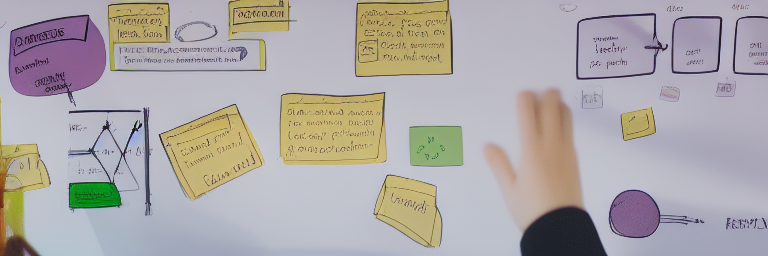What is design thinking?
Design thinking is an iterative problem–solving process that combines creative and analytical approaches to identify and solve complex problems. The process is based on understanding users, exploring and challenging assumptions, redefining problems, and creating innovative solutions. Design thinking uses methods from the fields of design, engineering, psychology and anthropology to develop creative insights and solutions that meet customer needs.
How it Works
Design thinking is a human–centered approach that encourages collaboration, experimentation, and iteration to find innovative solutions. Too, it is based on the belief that any problem can be solved through creative and thoughtful problem–solving. The process typically starts with research and analysis, followed by idea generation and prototyping, and ends with testing and implementation. Also, it can be applied to a wide range of problems, from the design of a new product to the redesign of a business process. Thus, it is a powerful tool for creating innovative solutions and can help organizations stay competitive in today’s rapidly changing market. Therefore, by taking a human–centered approach, it can uncover insights into customer needs, identify new opportunities, and create products and services that are tailored to the customer’s needs.
The Advantages of Design Thinking
- Foster Creative Problem Solving: Design thinking provides a structured approach to problem solving, which encourages creative solutions. By using a creative problem–solving process, businesses can come up with novel solutions to complex problems.
- Increase Collaboration: Design thinking encourages collaboration between different stakeholders, which leads to greater collaboration and improved communication. This allows businesses to benefit from the different perspectives of the different stakeholders.
- Improve User Experience: Design thinking puts the user at the center of the design process, which leads to improved user experience. By understanding the users and their needs, businesses are able to create products and services that are tailored to the users.
- Enhance Innovation: Design thinking encourages experimentation and encourages businesses to think outside the box. This leads to a greater capacity for innovation, which can lead to new products, services, or solutions.
- Save Time and Money: Design thinking allows businesses to create solutions faster and cheaper. By using a structured approach to problem solving, businesses are able to save time and money, which can be used for other things.
The Challenges of Design Thinking
Design thinking is a process that involves understanding and developing solutions to complex problems. Thus, it is a way of thinking that focuses on the user experience and allows for a holistic approach to problem solving. Too, despite the many benefits of design thinking, it can be difficult to implement in practice.
One of the biggest challenges of design thinking is the need to be creative. It requires practitioners to think outside the box, which can be difficult for those who are used to traditional problem–solving approaches. Also, design thinking also requires practitioners to be comfortable with ambiguity and uncertainty, which can be difficult for those who are used to clear–cut solutions.
Another challenge with design thinking is the need to manage stakeholders. It requires practitioners to engage with stakeholders in order to better understand their needs and come up with solutions to meet those needs. Too, this can be difficult as stakeholders often have competing interests and different perspectives on how to solve a problem.
Finally, design thinking can require a lot of time and resources. Design thinking is a process that involves a lot of iteration and experimentation, which can be time–consuming and expensive.
Additionally, design thinking requires practitioners to have certain skills, such as empathy and communication, which can be difficult to develop. It is a powerful tool for problem solving, but it can be difficult to implement in practice. Practitioners must be prepared to face the challenges of design thinking and be willing to invest the necessary time and resources to make the most of this approach.
Future Outlook
Design thinking is a problem–solving methodology that puts the user at the center of the design process. It has become increasingly popular in recent years and has been applied to a wide range of industries and disciplines, from software and product design to business strategy and organizational development. The future of design thinking is likely to see a further expansion of its use in a variety of contexts, as well as the development of new and innovative approaches to problem solving.
Its use will likely become more collaborative and interdisciplinary, as different groups of stakeholders come together to explore new solutions. This will also involve a greater focus on the integration of technology, with designers working closely with engineers and data scientists to develop more complex and sophisticated solutions.
Design thinking will continue to be used to tackle complex problems, such as those involving multiple stakeholders, ethical considerations, and global implications. Companies and organizations will increasingly rely on it to develop strategies and plans that are responsive to changing conditions and customer needs.
Moreoever, as it becomes more prevalent, it is likely that it will evolve and become more sophisticated. We may see more emphasis on user research, with a greater emphasis on understanding user needs and preferences, as well as more sophisticated techniques for synthesizing and analyzing data.
As the future of it is likely to involve a greater emphasis on sustainability, as designers explore ways to create products and services that are both economically and environmentally friendly. This could involve looking at the lifecycle of a product or service, from its materials to its end of life.
Overall, the future of design thinking looks bright. As more people begin to recognize the value of this approach to problem–solving, we can expect to see a greater emphasis on collaboration, problem–solving, and innovation.

